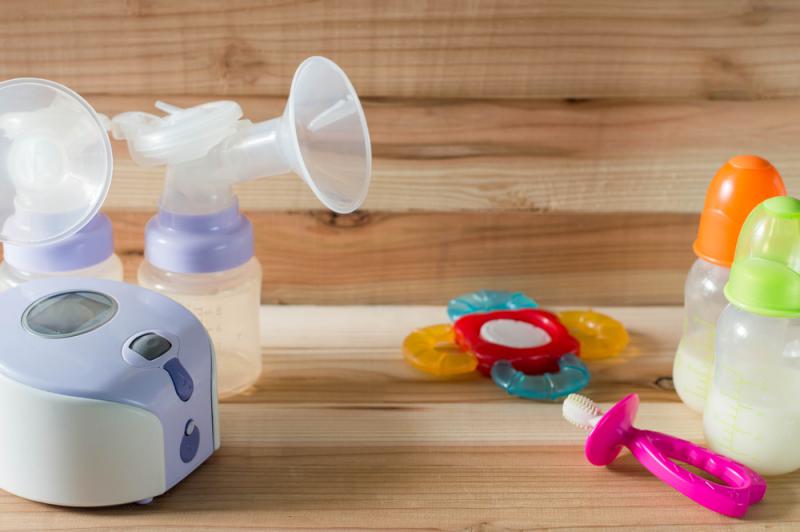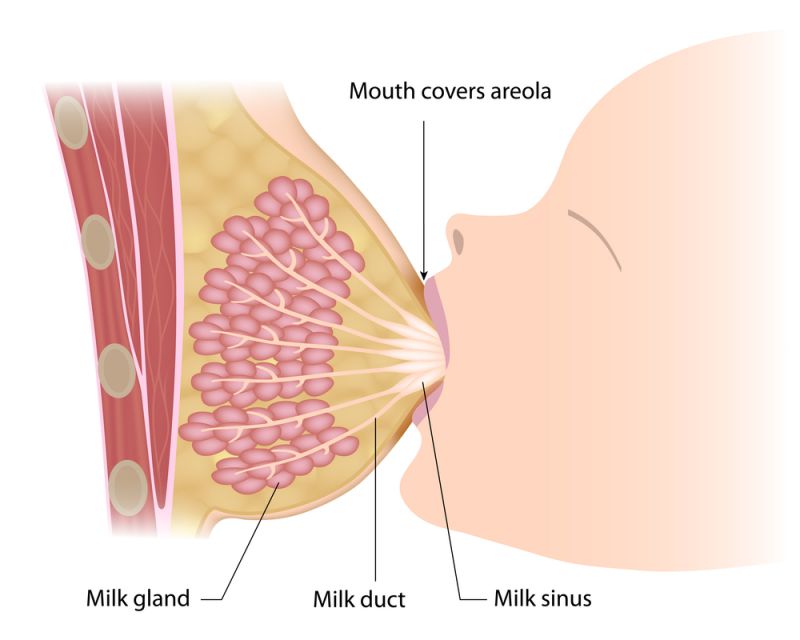Blocked Milk Ducts: Causes, Symptoms, Treatment & Prevention

After the journey of pregnancy comes the journey of motherhood.
Thankfully, over the past nine months, your body and its hormones have been kicking into gear, making sure the natural instincts are ready to handle the baby once it comes out into the real world.
One of the most natural reactions to new motherhood is breastfeeding. This experience is different for all women and there is no ‘right or wrong’ way to breastfeed a newborn. For some women it happens within an hour after giving birth, others might need more time.
Either way, the milk has been brewing in the breasts in the final trimester and it is ready to start being suckled out.
The first thing that you’re going to notice about the breastfeeding chapter is that is it unpredictable. One day, the flow might be long and steady with no issues. The next day, just a few trickles will come out. So, what is going on here?
There are many reasons why the milk flow changes.
One of the most common instances is a blocked milk duct!
Through this article we will explore the causes, effects, and treatment of blocked milk ducts. Knowledge is power when it comes to the mystery of the female body so being aware that these things can happen is the first step to empowering yourself while breastfeeding.
What is a blocked milk duct?
As the phrase suggests, this is when the milk duct is experiencing a blockage. The body is designed to produce milk to feed the newborn baby.
Sometimes, the milk ducts can get a little over-excited and produce too much milk at a time. If the milk isn’t nursed and expressed to keep up with the flow, it can become backed up in the ducts.
A blocked milk duct can occur in different parts of the breasts. The milk flow might be obstructed in the pore of the nipple or further back in the ductal system.
Most of the time, only one breast is affected by a blockage. The location or site of the blockage can move around and it generally happens as a gradual process.
What causes a blocked milk duct?
Like with the causes of anything going on in the body, these are plentiful.
1. Excess milk production

The most common reason for the blockage is excess milk production. This is when the milk simply isn’t moving fast enough and is sitting in the tubes, waiting to come out. If it doesn’t make it out, it can rest for too long and become blocked.
2. Pressure on the breasts

Another explanation is pressure on the breasts. A tight bra, such as a sports bra, or anything else that restricts the breasts, even carrying the baby around on the chest, can wreak havoc on the milk ducts. To prevent these things from happening, it is important to give your breasts time to breathe through the day. Avoiding sleeping on the breasts is a good place to start. Also, after exercising, take off the sports bra and let the breasts circulate freely. Giving them a light massage after tight bras or restrictions have been on them is advisable.
3. Pumping breast milk

Similar to drainage issues, blockages can occur when pumping breast milk. If the pump isn’t strong enough, it can affect the flow and production. Using a good quality pump is the best thing to do for this.
4. Improper Latch

Now, since it is the baby who needs to the breast milk, it is crucial to make sure they are latching well. If the baby isn’t latching strongly enough, the drainage won’t keep up with the flow of production. If you and the baby are experiencing latching difficulties, it is a good idea to see a lactation specialist and sort the problem out sooner rather than later.
5. Weaning a baby too quickly

Furthermore, weaning a baby too quickly can cause milk ducts to block. If there is still milk being produced and flowing into the ducts, but not being drained, they are going to get blocked. Even after weaning the baby, continue pumping and draining to make sure all milk is getting out of the body and not sitting in the breasts.
6. Stress

Finally, there is stress. Any amount of stress is going to cause problems during the breastfeeding stages. Of course, some stress is inevitable due to the messed up sleeping routine and extra pressure on the baby. However, self-care during this time is essential. Make sure you have a break, put your feet up, and enjoy a relaxing cup of tea to remove stress and let the body work its wonders naturally.
What are the symptoms of a blocked milk duct?
The most obvious symptom that you’re going to find is that the milk isn’t coming out as well as it should. This can be hard to tell at first when still getting into a rhythm of breastfeeding. The best thing to do is trust your instinct – if it doesn’t feel right, it probably isn’t.
Another noticeable warning sign is pain in the breasts. Some women first notice a firm or bumpy area on the breast. This can be painful and uncomfortable. If there is any swelling or redness on the breast and something that feels like a small lump or bruise, it is most likely a blocked milk duct. Also look out for areas of the breast that are warm to touch as this is another sign.
Treatment: What to unclog a blocked milk duct?
A blocked milk duct isn’t the worst thing that can happen during new motherhood. It doesn’t necessarily call for a visit to the doctor unless it gets really severe. If things get too bad, it can lead to mastitis, which is an infection in the breasts that will need antibiotics. The time to see a doctor is when there is too much heat and swelling in one area of the breasts and a fever starts.
The good news is that a blocked milk duct can be sorted out in the comfort of home before it gets too severe.
1. Let the milk continue to flow

Although there is pain associated with feeding or pumping when one of the milk ducts is blocked, keeping on is the first thing to do. Letting the milk continue to flow is the first step to resolving it.
2. Stay hydrated

Also, you should stay hydrated and get plenty of water into the body. This helps to stimulate the breast milk, giving it a lighter consistency to flow through the ducts. Hydration is also important to any element of health and wellbeing so should never be overlooked.
3. A hot or cold compress

A hot compress is another good solution. This can relieve some of the pain of the site. Using a hot compress in addition to a lanolin cream can help to calm the milk ducts down and stimulate a good flow again. Similarly, taking a hot shower and spraying warm water directly onto the nipple can relieve the discomfort.
Some women prefer cold relief to hot which also works in this case. A cold compress or cold water sprayed directly around the nipple can also be a good solution to ease things up.
Does a blocked milk duct last for a long time?
The first answer is that hopefully it won’t! To ease and relieve a blocked milk duct, being proactive is the most important thing. As soon as signs of trouble arise, start treating the breast with heat and massage quickly. Also, be sure to check how the baby is latching.
Most of the time, a blocked milk duct will resolve itself within a day or two, as long as you are caring for the breasts well. If the pain and discomfort continues for more than two days, getting an appointment at the doctor is recommended. This is the time when it might develop into mastitis and need more serious treatment.
Prevention: Is it possible to avoid blocked milk ducts?
Staying healthy and stable is the best prevention for anything going wrong with breastfeeding and new motherhood. Taking care of yourself and looking after the body is important. As mentioned earlier, staying away from excess stress and putting time and effort into self-care helps a lot. This includes getting enough sleep, eating healthy, and drinking plenty of water.
In terms of the breasts, giving them regular massages and using a heat compress or warm water in the shower can help to stimulate milk flow, preventing blockages from occurring. The main thing to do is to take care of the breasts and understand how important they are during this time.
Wearing appropriate clothing around the breasts is also useful. Now is not the time to try out a super cute tight top! Rather, go with loose and flowy clothes so that the breasts can breathe nicely. Make sure to wear a proper, supportive bra that isn’t too tight.
Exercising is still important during the first few months to help get the body back into shape. However, avoid exercises that make the breasts bounce too much. A nice cycle, swim, or walk is better than an intense run or jumping around a gym class.
You May Also Like
Most Viewed
-
5 Common Methods of Contraception
Last updated On by Percy Oad -
How to Cope with Male Infertility
Last updated On by Alina -
What is the Difference Between Primary and Secondary Infertility?
Last updated On by Madison -
How to start a child-free life after infertility
Last updated On by Jacinta








